



















|
 |
|
 |

The units listed under Hellenic are common Hellenic troops you can recruit from a wide geographical area, often ranging from Greece to Baktria. There is also a list of the most common North African units you will face when fighting the Eleutheroi and units from northeastern Africa, or from Egypt to Ethiopia.
Klerouchoi Phalangitai (Hellenic Medium Phalanx)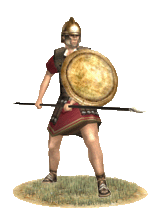 The Klerouchoi Phalangitai form the backbone of the Successor armies of Aigyptos and Asia, along with the less numerous Pezhetairoi. These men are given a plot of land or kleros, maybe some slaves and a tax reduction and in return they serve in the phalanx when called upon to war by their Basileus. They are citizens just as the Pezhetairoi, but they are citizens with-strings-attached, as they are required to fight when called upon or otherwise their livelihood might be taken away from them. The Klerouchoi Phalangitai form the backbone of the Successor armies of Aigyptos and Asia, along with the less numerous Pezhetairoi. These men are given a plot of land or kleros, maybe some slaves and a tax reduction and in return they serve in the phalanx when called upon to war by their Basileus. They are citizens just as the Pezhetairoi, but they are citizens with-strings-attached, as they are required to fight when called upon or otherwise their livelihood might be taken away from them.
Even though the phalanx is a Hellenic soldier formation, some Thraikes, Keltoi, Ioudaioi and other subjects were also given Klerouchos status to increase the number of Phalangitai available, but the main bulk of the Klerouchoi Phalangitai are still Hellenes. Each soldier is armed with the sarissa and wears a linen or leather cuirass, a Thracian helm, and a Makedonian pelte provided by the Basileus. In battle they are best deployed in a defensive posture, or in a slow but steady advance towards the enemy, grinding down their opponents' numbers through attrition, or to pin enemy formations so they can be flanked by other units.
The wars which followed the breakup of Megas Alexandros' empire drained the Makedonian armies of many of their Makedones. For the western Diadochoi, levies from populations could take place directly, but the eastern Diadochoi depended on their dwindling standing armies or on new mercenary recruits. They needed a renewable source of Hellenic recruits if they were to keep power and retain their military strength. As the pike-phalanx was the backbone of their armies, they needed Hellenes to fill its ranks. While mercenaries could temporarily fulfill such a need, their loyalty was never assured, while their demands for pay always were.
The answer was the establishment of Hellenic military-settlements throughout the Successor states, where a soldier was given a plot of land and reduced taxes. Sometimes they were given some slaves too, to work their alloted land, freeing up more time for the Klerouchos soldier to be on campaign. Arming the native population (Aigyptioi in the Ptolemaic kingdom, Syriakoi and Babylonioi in the Seleukid Empire), was less appealing, as that would have laid the Makedonian dynasties open for native revolts in their respective heartlands. In Aigyptos most Klerouchoi were settled in the Fayum depression, but many others were settled further to the south, though in smaller numbers.\n\nKlerouchoi were also settled by the Ptolemaioi in settlements in Asia, Kypros, and Koile Syria, but nearly all Hellenic, Klerouchoi Phalangitai were settled in Aigyptos, and primarily in the Arsinoite and Herakleopolite nomes, in or near the Fayum. In the Arche Seleukeia these settlements, called Katoikiai, were established in western Asia around Sardis, throughout Syria and Mesopotamia, and as far away as Baktria and Paropamisadai. The Klerouchoi population in Aigyptos eventually deteriorated, and lost much of its martial character after the arrival of the Romans, while the Katoikiai in Seleukid regions, especially those in western Asia, passed into the hands of the Pergamenes first, then Pontos, and finally the Romaioi.
Misthophoroi Peltastai (Mercenary Hellenic Heavy Skirmishers)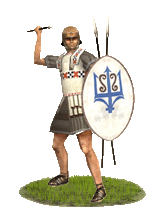 The Peltastai is a type of elite skirmisher that sacrifices heavy arms and armor for mobility and range. They are armored in linen and carry a medium sized ovular shield. Originally, they carried a crescent shaped ‘pelta’ shield, originated in Thrake and gave the Peltastai their name, but this was phased out in the fourth century. Their armaments consist of several javelins and a sword. This panoply makes them light and mobile, but still able to engage in melee after their javelins have been thrown. They are a versatile unit but one must remember that their primary arms are javelins, and they are not equipped to stand toe to toe with heavier infantry. Their role is one of speed, harassment, and critical flanking maneuvers. The Peltastai is a type of elite skirmisher that sacrifices heavy arms and armor for mobility and range. They are armored in linen and carry a medium sized ovular shield. Originally, they carried a crescent shaped ‘pelta’ shield, originated in Thrake and gave the Peltastai their name, but this was phased out in the fourth century. Their armaments consist of several javelins and a sword. This panoply makes them light and mobile, but still able to engage in melee after their javelins have been thrown. They are a versatile unit but one must remember that their primary arms are javelins, and they are not equipped to stand toe to toe with heavier infantry. Their role is one of speed, harassment, and critical flanking maneuvers.
Historically, the Peltastai were often Hoplitai or Pezhetairoi equipped to fight in the manner of a skirmisher. This meant that they were adept melee combatants as well as being deadly with their javelins. Peltastai were used to great effect on ancient battlefields but by 270 BC the Thureophoros was becoming the dominant melee skirmisher and the Peltastai were carrying more javelins and were used in a manner that was consistent with this. This was simply a matter of specialization, and it did not mean that Peltastai would be any less effective if deployed correctly. Their light armament makes them extremely fast, but tends to be to their detriment in melee combat. They were mostly used in the role of supporting missile troops who charged in at the last moment, after they had spent all their javelins. The great Athenian general Iphikrates is credited with the invention of the peltast as a distinct unit, and it is he that first employed them in this manner to great effect against the heavier armored and better trained Hoplitai of Sparte.
Hippakontistai (Hellenic Skirmisher Cavalry)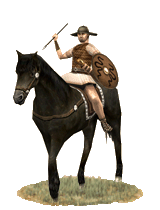 Hippos Akontistes (literally "cavalry javelineer") is the standard among Hellenic light cavalry. Hippakontistai are lightly armored, often wearing nothing but padded cloth for protection. The key to their method of warfare is speed, and they are armed accordingly. They ride small, but swift horses and harass enemy infantry and heavy cavalry with javelins. This is their primary use, because their light armor is really a detriment when they are engaged in any kind of melee combat. Their swords and shields are simply no counter to lances or heavier cavalry swords. Hippos Akontistes (literally "cavalry javelineer") is the standard among Hellenic light cavalry. Hippakontistai are lightly armored, often wearing nothing but padded cloth for protection. The key to their method of warfare is speed, and they are armed accordingly. They ride small, but swift horses and harass enemy infantry and heavy cavalry with javelins. This is their primary use, because their light armor is really a detriment when they are engaged in any kind of melee combat. Their swords and shields are simply no counter to lances or heavier cavalry swords.
Historically, Hellas did not have a great tradition of light cavalry warfare, or indeed of any cavalry warfare. Hippakontistai were much like the Equites of Rome, the spoiled children of the richest families that could afford horses. They were usually not used in any front line capacity other than skirmishing and pursuit, and their equipment reflects this. Makedonian cavalry of the same type operates in a similar fashion, but generally comes from the poorest noble families, those who can afford horses but not the heavy armor required for the heavy cavalry.
Misthophoroi Phalangitai (Mercenary Pikemen)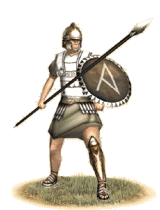 Misthophoroi Phalangitai are mercenary Pezhetairoi. These are the heart of the military machine of all the Diodachoi kindgoms. They are well disciplined and highly motivated pikemen that are armed and armored to the teeth. They are armored in a linen cuirass, a Thraikian cap, a bronze greave on the left leg, stout boots, good bracers, and reinforced shoulder pads made from hardened linen (due to their experience with the deadly curved swords of Thrace). They have Illyrian style round shields attached to their bodies by leather straps that help support the weight of the shield and keep their hand free to grasp the long and unwieldy sarissa. They are defensive infantry par excellence and are the anvil of the two part Makedonian system of warfare, the heavy cavalry being the hammer. They should be used to anchor enemy soldiers while the Thureophoroi harass the flanks and the heavy cavalry smashes into the flanks and rear. Misthophoroi Phalangitai are mercenary Pezhetairoi. These are the heart of the military machine of all the Diodachoi kindgoms. They are well disciplined and highly motivated pikemen that are armed and armored to the teeth. They are armored in a linen cuirass, a Thraikian cap, a bronze greave on the left leg, stout boots, good bracers, and reinforced shoulder pads made from hardened linen (due to their experience with the deadly curved swords of Thrace). They have Illyrian style round shields attached to their bodies by leather straps that help support the weight of the shield and keep their hand free to grasp the long and unwieldy sarissa. They are defensive infantry par excellence and are the anvil of the two part Makedonian system of warfare, the heavy cavalry being the hammer. They should be used to anchor enemy soldiers while the Thureophoroi harass the flanks and the heavy cavalry smashes into the flanks and rear.
Historically, the Pezhetairoi are the classic Alexandrian phalanx. They were used to great effect against the Persai, Medoi, Baktrioi, Indoi, Phoinikes, and many, many others. They are an effective force and have not changed much over the centuries. The Romaioi were able to defeat them as easily as they did for two main reasons. One, the Romaioi army was at a high state of readiness and tactical prowess after defeating the Karchedoi. Two, the heavy cavalry arm of the Diodochoi armies had degenerated to the point where they were no longer able to field significant numbers to fulfill their part of the hammer and anvil tactic of Alexandros. There were also many lesser reasons, numbering among them the misuse of the Thureophoroi, the under use of Peltastai, and the lax state of warfare that the Diodachoi states were used to. In any case, the phalanx was not as anachronistic or inflexible as widely believed; it was simply misused and under-supported. In the thirteenth century and onwards, pikemen in similar formations were able to work wonders with more capable generals and a better cavalry arm. Do not under appreciate pikemen, for they are still a war winning force.
Misthophoroi Thureophoroi (Mercenary Hellenic Spearmen)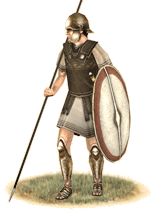 Thureophoroi were a new class of Hellenic infantry that was designed to both augment the phalanx and provide a type of soldier in between the Phalangite and the Peltast that was able to skirmish and fight in melee. They are an extremely mobile force that can hit hard with their heavy javelins then rush in to flank pike units. They are well armed and armored for the task, having stout bronze helms, linen armor, an almond shaped theuros shield, heavy javelins, and a stout spear. They are highly versatile infantry, akin in spirit to the legionaries of Rome. They are usually Pezhetairoi, middle class property owners with voting rights. As such, they are well able to devote time to training and practice. They have good morale and are highly disciplined. They were often described by Latin writers as copies of the legion. It is debatable whether they were developed with knowledge of warfare in Italy or not, they are a highly effective force of heavy infantry that is in the forefront of Hellenic military know-how. Thureophoroi were a new class of Hellenic infantry that was designed to both augment the phalanx and provide a type of soldier in between the Phalangite and the Peltast that was able to skirmish and fight in melee. They are an extremely mobile force that can hit hard with their heavy javelins then rush in to flank pike units. They are well armed and armored for the task, having stout bronze helms, linen armor, an almond shaped theuros shield, heavy javelins, and a stout spear. They are highly versatile infantry, akin in spirit to the legionaries of Rome. They are usually Pezhetairoi, middle class property owners with voting rights. As such, they are well able to devote time to training and practice. They have good morale and are highly disciplined. They were often described by Latin writers as copies of the legion. It is debatable whether they were developed with knowledge of warfare in Italy or not, they are a highly effective force of heavy infantry that is in the forefront of Hellenic military know-how.
Historically, Theurophoroi were used as harassing and flanking troops by the successor states. There seemed to be a lot of confusion as to how to utilize these new soldiers, since they were deadly in the extreme to the less mobile phalanx units. Most of the successor states used them conservatively, except for the Seleukides, who took to these new soldiers quite well. The city-states of Greece used them even more frequently against the armies of Makedonia, and were often able to hold the more powerful kingdom at bay. Still, their uses were limited in scope and not as widespread as their versatile and deadly role would have indicated. This is the fault of their commanders, however, and any more astute or innovative commander might have realized their potential in conjunction with the more static Phalanx.
Misteret Izrahim Tsorim (Poeni Citizen Militia)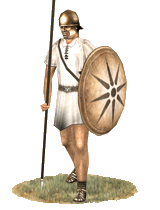 The Phoenician citizens of Kart-Hadast decided long ago that their numbers were too small to make up a major part of the regular army of their city's imperial holdings. Their wealth made it possible for them to hire vast amounts of foreign soldiers and mercenaries to fight for them. Because of this, most Karthadastim fight only when there is a need for the defense of Carthage itself. When they do fight, they fight as a militia phalanx, with spears and swords. They wear Attic style helmets, copied from the Greeks of Sicily. The Carthaginian citizens use the large bronze aspis of the Greeks as well, but are lightly armored to take advantage of some mobility when not in formation. Still, they are militia, and should not be expected to hold crucial portions of the battle line for any significant amount of time. They are brave, but it is a bravery borne of desperation. They will not hold long if flanked or if hit with a better armed and trained group of infantry. The Phoenician citizens of Kart-Hadast decided long ago that their numbers were too small to make up a major part of the regular army of their city's imperial holdings. Their wealth made it possible for them to hire vast amounts of foreign soldiers and mercenaries to fight for them. Because of this, most Karthadastim fight only when there is a need for the defense of Carthage itself. When they do fight, they fight as a militia phalanx, with spears and swords. They wear Attic style helmets, copied from the Greeks of Sicily. The Carthaginian citizens use the large bronze aspis of the Greeks as well, but are lightly armored to take advantage of some mobility when not in formation. Still, they are militia, and should not be expected to hold crucial portions of the battle line for any significant amount of time. They are brave, but it is a bravery borne of desperation. They will not hold long if flanked or if hit with a better armed and trained group of infantry.
Historically, a Carthaginian citizen phalanx was of poor quality. They lived pampered lifestyles in comparison to citizens of other nations, and their abilities reflect this. Carthage did not use citizens outside of elite military units unless there was a dire need to do so. They were used during the Roman invasion in the first Punic War and at the battle of Zama to little effect. Citizens who wished a martial career could join the cavalry or the Sacred Bands. There was little incentive for merchants to fight wars…
Mitnag'him Numidim (Numidian Skirmishers)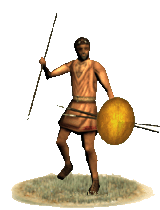 Numidian javelinmen are fast moving skirmishers trained from infancy in the use of the javelin for hunting. They are recruited from amongst nomadic peoples who need their weapon skills to survive in harsh conditions. Numidian javelinmen are fast moving skirmishers trained from infancy in the use of the javelin for hunting. They are recruited from amongst nomadic peoples who need their weapon skills to survive in harsh conditions.
They are best employed to harry enemies and thin their ranks with volleys of missiles. They should avoid being sucked into hand-to-hand combat, as their knives are more useful in skinning animals than killing men; also, other than a small shield they have no armour.
Qala'im Numidim (Numidian Slingers)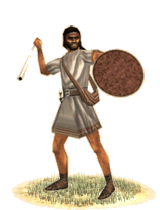 Numidian slingers came from the shepherd nomads who used their slings to protect their herds from predators. They're quite skilled with their slings, which truly is a deceptively simple weapon. One end of the sling is looped around his wrist while the other is released when the stone is launched. A sling bullet would not be seen in flight and was capable of shattering a shield or penetrating unarmored flesh to a range of about 100 metres when slung by a skilled man.
Numidian slingers came from the shepherd nomads who used their slings to protect their herds from predators. They're quite skilled with their slings, which truly is a deceptively simple weapon. One end of the sling is looped around his wrist while the other is released when the stone is launched. A sling bullet would not be seen in flight and was capable of shattering a shield or penetrating unarmored flesh to a range of about 100 metres when slung by a skilled man.
Numidian slingers are best used as light skirmishers. With no armor and very simple melee weapons, they rush forward toward the enemy to pepper them with stones, only to flee when threatened.
Historically, slingers seem to have been used in almost all corners of the world in some form and North Africa was no exception.
Hand slings are very easy and cheap to make, and yet they are a respectable weapon. They generally consisted of a single long strip of leather or woven wool, with a central "pocket" for the stone. The longer the sling, the greater its range.
Kasatim Numidim (Numidian Archers)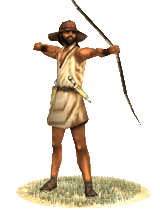 Ever since the dawn of our people, we have fought from a distance. With sling and javelin we conquered the sands, only the cowardly settled people behind their walls resisting our might. When the Phoenicians came, they conspired with our settled cousins and drove us into our desert homeland. To our shame, the newcomers had a weapon that could outperform our traditional arms. But we adapted, we adopted, and we gained prominence again. With their composite bows in our hands, we became the most feared and sought after archers in the Western Mediterranean. We wear none of the coward's armor, for it slows us in battle. Our stout Canaanite bows deliver death from afar, sending heavy arrows tearing through the ranks of the armored enemy. With a hat-helm protecting us from the harshness of the sun, we can deliver volley after volley of indirect fire. When the enemy is routed, we descend upon him like ravenous hyenas, and bash their heads in with our cudgels. If attacked up close, we can give a good enough account of ourselves, as our weapons will tackle all but the most heavily armored infantry, but we believe this is a waste of good archers. Use us wisely, general, and remember that we can win battles for you if employed properly. Ever since the dawn of our people, we have fought from a distance. With sling and javelin we conquered the sands, only the cowardly settled people behind their walls resisting our might. When the Phoenicians came, they conspired with our settled cousins and drove us into our desert homeland. To our shame, the newcomers had a weapon that could outperform our traditional arms. But we adapted, we adopted, and we gained prominence again. With their composite bows in our hands, we became the most feared and sought after archers in the Western Mediterranean. We wear none of the coward's armor, for it slows us in battle. Our stout Canaanite bows deliver death from afar, sending heavy arrows tearing through the ranks of the armored enemy. With a hat-helm protecting us from the harshness of the sun, we can deliver volley after volley of indirect fire. When the enemy is routed, we descend upon him like ravenous hyenas, and bash their heads in with our cudgels. If attacked up close, we can give a good enough account of ourselves, as our weapons will tackle all but the most heavily armored infantry, but we believe this is a waste of good archers. Use us wisely, general, and remember that we can win battles for you if employed properly.
Historically, the Numidian peoples lacked all but the simple bow until the arrival of Phoenicians at the end of the Bronze Age. Though it took some time, Numidians began to take up the bow with tremendous vigor. Soon, Carthage itself was replacing Phoenician archers with Numidian, and sending the former to become Marines in her great navy. Numidian archers were battle winners for the Romans as well, giving extremely good accounts of themselves under Caesar and against the Celts and Germans who resisted the onslaught of Rome.
Parasim Numidim (Numidian Cavalry)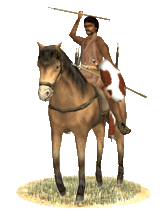 Numidia produces some of the finest cavalry in all Africa, if not the Western Mediterranean world. Armed with javelins, these mounted skirmishers can be a nightmare for an opponent as it can prove practically impossible to pin them down in combat. Their tactics are to pelt the enemy with deadly volleys of javelins, and then swiftly retreat when charged. If the enemy stand, they are slaughtered with volleys of javelins, and if they run the Numidian cavalry can ride them down! Numidia produces some of the finest cavalry in all Africa, if not the Western Mediterranean world. Armed with javelins, these mounted skirmishers can be a nightmare for an opponent as it can prove practically impossible to pin them down in combat. Their tactics are to pelt the enemy with deadly volleys of javelins, and then swiftly retreat when charged. If the enemy stand, they are slaughtered with volleys of javelins, and if they run the Numidian cavalry can ride them down!
Instinctive riders, the Numidians are famed for not using a saddle or reins, using only a stick to direct their horses. Nevertheless, they maneuver with the "grace of a flock of birds". Having adapted to the broken expanses of their homelands, Numidian cavalry have great stamina, and they are also experts in their form of the Cantabrian circle attack.
Gldgmtk (Numidian Nobles)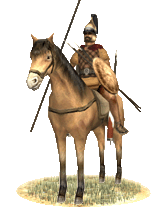 The Numidian Nobles are the high ranking class of Numidia. Trained in the hit and run tactics of their lower caste comrades they also wield heavier equipment and armour. These heavier cavalry are capable bodyguards and can be effective on the charge but they are not on the same class as the heavy cavalry of other lands. Their greatest use lies in their speed, maneuverability, and accuracy with their javelins. The Numidian Nobles are the high ranking class of Numidia. Trained in the hit and run tactics of their lower caste comrades they also wield heavier equipment and armour. These heavier cavalry are capable bodyguards and can be effective on the charge but they are not on the same class as the heavy cavalry of other lands. Their greatest use lies in their speed, maneuverability, and accuracy with their javelins.
Historically, in Numidia there was a class of nobles that ruled under the chiefs and kings and later under the sole king of Numidia. These nobles existed in both parts of Numidia, Numidia as it is known today which was dominated by the Massylians, and further north west where the area was dominated by the Masaesylian Numidians. These nobles often acted as the bodyguards and royal soldiers of the king, particularly under the reign of Jugurtha. In Sallust’s account of the Jugurthine war he mentions that in a route, only the Royal Cavalry could be counted upon to remain at the King’s side and not disperse into the countryside. The term GLDGMTK used here is from the Libyan dialect spoken by the Numidians and comes from several noble titles on inscriptions from the town of Thugga. The title translates loosely as 'Prefect of Fifty'. The other common title in Thugga was 'Chief of One Hundred'. The Numidian kings later chose to use Spanish and Gaulish mercenaries as their bodyguards instead of relying on the noble class.
Dorkim Garamantim (Garamantine Infantry)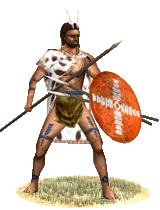 The Garamantine warriors are masters of hit and run tactics. Striking in raids from their oasis strongholds they attack towns, outposts, watchtowers, and nomadic tribes. They fight first with throwing spears and javelins but can close or hold when necessary with their spears and leather shields. They wear ostrich feathers tied to their heads to make them appear more fearsome and impressive and wear a cow skin cloak for protection both on the battlefield and against the natural environment. The Garamantine warriors are masters of hit and run tactics. Striking in raids from their oasis strongholds they attack towns, outposts, watchtowers, and nomadic tribes. They fight first with throwing spears and javelins but can close or hold when necessary with their spears and leather shields. They wear ostrich feathers tied to their heads to make them appear more fearsome and impressive and wear a cow skin cloak for protection both on the battlefield and against the natural environment.
The Garamantines were a group of Berber tribes living in North central Africa on the fringe of the Sahara desert that herded cattle and irrigated farmland. They conducted raids against towns to the North and against the nomadic Saharan people known to the Greeks as the Troglodytai. The Garamantines reached dominance in the second and third century AD and are often referred to as one of the first great Berber nations. They fought on foot, from horseback and from chariots. Much of the evidence for their equipment comes from their own rock art and Egyptian paintings of Libyan soldiers. Herodotos refers to the Garamantes as a fierce and aggressive tribe that would hunt down the Troglodytai but also says that they are a people who know little of war. Herodotos made the Garamantines famous for his fanciful tale of the cattle they raised which supposedly had horns so long they had to graze backwards.
Dorkim Maurim (Maure Infantry)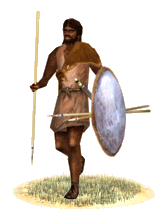 Maure infantry are fast moving skirmishing troops used by the Carthaginians and Berber chieftains. They are recruited from the most Western provinces of North Africa. A land known by their warriors and their unique fighting style. They are armed with javelins and a sword of North African origin, similar to the Takouba used these days by the Tuareg people. The Maures are protected by a shield made of elephant hide and by a tunic made of animal fur that they use like it was a breastplate.
Maure infantry are fast moving skirmishing troops used by the Carthaginians and Berber chieftains. They are recruited from the most Western provinces of North Africa. A land known by their warriors and their unique fighting style. They are armed with javelins and a sword of North African origin, similar to the Takouba used these days by the Tuareg people. The Maures are protected by a shield made of elephant hide and by a tunic made of animal fur that they use like it was a breastplate.
They should avoid being sucked into hand-to-hand combat, as they do better in the job of harassing the enemy with their javelins. Their tactics are to pelt the enemy with deadly volleys of javelins, and then swiftly retreat when charged.
Historically, Maures were very similar to their Numidian neighbors. Greek and Roman historians say they were darker than other North African tribes, to the point to be called “Western Ethiopians”. They were also great warriors and were one of the troops mentioned by Hannibal in his inscription left in Italy.
Machimoi (Native Egyptian Infantry)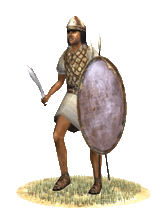 The Machimoi were an important part of Aigyptian society long before the arrival of the Hellenes and the new Pharoanic dynasty of the Ptolemaioi. Aigyptian society consisted, aside from the royal family, primarily of the priests, the warriors--or Machimoi, and the farmers. These men are drawn from the largest section of the Machimoi, and armed with several javelins, a sword, and a shield, and armored with a light cuirass and mass-produced helmet. They are competent in basic wartime and garrison duties, but should not be expected to succeed in combat against well-trained units or in other daunting situations. They may once have been a warrior class, but for hundreds of years many of the Machimoi have spent most of their lives farming or trading, not fighting. The Machimoi were an important part of Aigyptian society long before the arrival of the Hellenes and the new Pharoanic dynasty of the Ptolemaioi. Aigyptian society consisted, aside from the royal family, primarily of the priests, the warriors--or Machimoi, and the farmers. These men are drawn from the largest section of the Machimoi, and armed with several javelins, a sword, and a shield, and armored with a light cuirass and mass-produced helmet. They are competent in basic wartime and garrison duties, but should not be expected to succeed in combat against well-trained units or in other daunting situations. They may once have been a warrior class, but for hundreds of years many of the Machimoi have spent most of their lives farming or trading, not fighting.
The Ptolemaioi eventually organized the Machimoi class into three distinct levels: the 5-aroura machimoi, the 7-aroura Machimoi, and the Machimoi epilektoi. The machimoi epilektoi formed the auxiliary phalanx at Raphia, and may not have existed until the reforms leading up to the Raphia campaign. The 5-aroura Machimoi served as light troops: Toxotai, Akontistai, and the like, and may have been part of the recruitment pool for the Phulakitai, the regional police. These are the 7-aroura Machimoi, who likely saw extensive use on a reserve basis in the Ptolemaic fleets, in various garrisons both in Aigyptos and overseas, and on both sides of the many civil wars which wracked the Ptolemaic state from the late third century on. While this population initially consisted almost exclusively of native Aigyptians, years of immigration and Hellenization have changed the makeup of the Machimoi to a considerable degree. While it still maintained a native Aigyptian character, the vast majority of Machimoi had first- or second-generation Hellenic, Asian, Galatian, or Thraikian ancestors.
Machimoi Phalangitai (Machimoi Native Phalanx)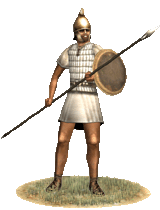 The Machimoi are Aigyptioi natives who have been conscripted to fight in the traditional Makedonian fashion. They are armed with all the standard phalanx equipment including the sarissa, the Phrygian cap, and the small Illyrian shield. They wear quilted cloth armor due to the harsh Aigyptian climate. They are reputable enough fighters, but have a history of rebellion, so they are far more expensive than most troops of the same caliber. This has to be dealt with though, since the Ptolemaioi simply do not have the numbers of Hellenes to fill their armies with. Machimoi have decent morale and can be relied upon as capable troops. Their weaknesses are the same as any pike phalanx, in that they are immobile and prone to flank attacks and missile fire. If used accordingly, they will give good account of themselves. The Machimoi are Aigyptioi natives who have been conscripted to fight in the traditional Makedonian fashion. They are armed with all the standard phalanx equipment including the sarissa, the Phrygian cap, and the small Illyrian shield. They wear quilted cloth armor due to the harsh Aigyptian climate. They are reputable enough fighters, but have a history of rebellion, so they are far more expensive than most troops of the same caliber. This has to be dealt with though, since the Ptolemaioi simply do not have the numbers of Hellenes to fill their armies with. Machimoi have decent morale and can be relied upon as capable troops. Their weaknesses are the same as any pike phalanx, in that they are immobile and prone to flank attacks and missile fire. If used accordingly, they will give good account of themselves.
Historically, the Machimoi were used with good effect at Rhaphia and other battles. Once they realized their own power, however, they soon began to revolt against their Hellenic and Makedonian rulers. The Ptolemaioi looked for different racial groups to settle in Aigyptos to counter this disparity, and ended up importing large amounts of Ioudaioi and Galatai to fill the ranks. Still, the Machimoi were used as a necessity, and often gave good accounts of themselves in battle.
Aithiopikoi Toxotai (Ethiopian Archers)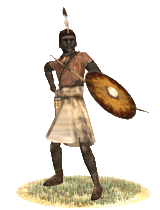 Skirmishers form the backbone of any Ethiopian army, especially bowmen. Hunting being an important part in Ethiopian life, at least in the interior plains and mountains means there is no shortage of able archers to call upon from the Ethiopian lands. In addition to their bow, every archer also carries a club for close combat should it happen, and they also carry shields. Depending on from which region these archers are raised, some might march to war in simple tunics while others prefer to fight without. As long as these archers are used in their intended battlefield role, that of archery they will do their duty well and should they be caught in close combat their clubs & shields will help them a bit, but a wise general should not expect these men to hold out in any prolonged melee. Skirmishers form the backbone of any Ethiopian army, especially bowmen. Hunting being an important part in Ethiopian life, at least in the interior plains and mountains means there is no shortage of able archers to call upon from the Ethiopian lands. In addition to their bow, every archer also carries a club for close combat should it happen, and they also carry shields. Depending on from which region these archers are raised, some might march to war in simple tunics while others prefer to fight without. As long as these archers are used in their intended battlefield role, that of archery they will do their duty well and should they be caught in close combat their clubs & shields will help them a bit, but a wise general should not expect these men to hold out in any prolonged melee.
Historically, ancient Ethiopia (encompassing modern day Eritrea and northern Ethiopia) was at this time made up of many smaller kingdoms that waged wars against each other, but also against any foreign invaders, like the Nubians, Hellenes and Sabaeans. There were basically three main regions in ancient Ethiopia; the coastal lowlands along the Erythrean Sea, the interior plains and the mountains separating them. The coastal lowlands seem to have been the most prosperous and were often raided by the mountain kingdoms. Most evidence indicates that the Ethiopians living along the Erythrean Sea were the most urbanized and also the most influenced by foreigners who established colonies and trade posts along the coast, like the Hellenes and Sabaeans and when it came to the latter, adopted their religious practices, which was a legacy of the earlier Sabaean rule in Ethiopia or D’mt as it was also called, although to which extent Ethiopia was ruled or if it was ruled at all by Sab’yn is a matter of debate. There are also evidences of Judaism being prevalent in ancient Ethiopia due to archaeological findings of temples and altar stones from 500 BC on, resembling ancient Jewish temples and sacrificial altars from 800-600 BC.
Ethiopian warfare at this time seems to have been similar to that of their Nubian neighbours, but there were regional variations in arms and armor when it came to materials used. The dominant type was skirmishers armed with either javelins or bows, and sometimes on horseback. They would also be armed with clubs for close combat. Spearmen were also used and the coastal peoples also fielded small, but elite contingents of swordsmen, either influenced or equipped by foreigners, serving often as bodyguards for kings or chieftains.
Hanatim Kushim (Ethiopian Light Spearmen)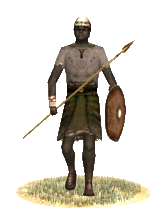 Even though archery and skirmishing is the mainstay method of war in Ethiopia, close combat also plays an important part, in which spearmen are used. These men are equipped with spears, shields and helmets which quality might change depending who is levying these troops, either it be a native king of the many small mountain kingdoms or a Sabaean general recruiting troops for a campaign. These spearmen can be expected to do their job well as light line infantry, but their lack of armor means they will have problems facing heavier equipped infantry and might be at a disadvantage against missile troops firing from an angle not covered by their shields. Even though archery and skirmishing is the mainstay method of war in Ethiopia, close combat also plays an important part, in which spearmen are used. These men are equipped with spears, shields and helmets which quality might change depending who is levying these troops, either it be a native king of the many small mountain kingdoms or a Sabaean general recruiting troops for a campaign. These spearmen can be expected to do their job well as light line infantry, but their lack of armor means they will have problems facing heavier equipped infantry and might be at a disadvantage against missile troops firing from an angle not covered by their shields.
Historically, ancient Ethiopia (encompassing modern day Eritrea and northern Ethiopia) was at this time made up of many smaller kingdoms that waged wars against each other, but also against any foreign invaders, like the Nubians, Hellenes and Sabaeans. There were basically three main regions in ancient Ethiopia; the coastal lowlands along the Erythrean Sea, the interior plains and the mountains separating them. The coastal lowlands seem to have been the most prosperous and were often raided by the mountain kingdoms. Most evidence indicates that the Ethiopians living along the Erythrean Sea were the most urbanized and also the most influenced by foreigners who established colonies and trade posts along the coast, like the Hellenes and Sabaeans and when it came to the latter, adopted their religious practices, which was a legacy of the earlier Sabaean rule in Ethiopia or D’mt as it was also called, although to which extent Ethiopia was ruled or if it was ruled at all by Sab’yn is a matter of debate. There are also evidences of Judaism being prevalent in ancient Ethiopia due to archaeological findings of temples and altar stones from 500 BC on, resembling ancient Jewish temples and sacrificial altars from 800-600 BC.
Ethiopian warfare at this time seems to have been similar to that of their Nubian neighbours, but there were regional variations in arms and armor when it came to materials used. The dominant type was skirmishers armed with either javelins or bows, and sometimes on horseback. They would also be armed with clubs for close combat. Spearmen were also used and the coastal peoples also fielded small, but elite contingents of swordsmen, either influenced or equipped by foreigners, serving often as bodyguards for kings or chieftains.
Aithiopikoi Machairophoroi (Ethiopian Swordsmen)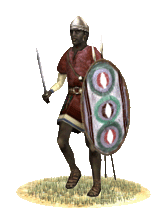 Ethiopian Swordsmen are in most cases raised from the population living along the coastlands of the Erythrean Sea by foreign overlords or Ethiopian rulers heavily influenced by foreigners and their ways. These men are equipped with helmets & shields only as body armor would only burden a soldier in the hot climate of Ethiopia. They also carry swords and javelins into battle. These men are the elite among Ethiopian troops, and can be expected to fulfil their role as assault infantry as long as properly used. Ethiopian Swordsmen are in most cases raised from the population living along the coastlands of the Erythrean Sea by foreign overlords or Ethiopian rulers heavily influenced by foreigners and their ways. These men are equipped with helmets & shields only as body armor would only burden a soldier in the hot climate of Ethiopia. They also carry swords and javelins into battle. These men are the elite among Ethiopian troops, and can be expected to fulfil their role as assault infantry as long as properly used.
Historically, ancient Ethiopia (encompassing modern day Eritrea and northern Ethiopia) was at this time made up of many smaller kingdoms that waged wars against each other, but also against any foreign invaders, like the Nubians, Hellenes and Sabaeans. There were basically three main regions in ancient Ethiopia; the coastal lowlands along the Erythrean Sea, the interior plains and the mountains separating them. The coastal lowlands seem to have been the most prosperous and were often raided by the mountain kingdoms. Most evidence indicates that the Ethiopians living along the Erythrean Sea were the most urbanized and also the most influenced by foreigners who established colonies and trade posts along the coast, like the Hellenes and Sabaeans and when it came to the latter, adopted their religious practices, which was a legacy of the earlier Sabaean rule in Ethiopia or D’mt as it was also called, although to which extent Ethiopia was ruled or if it was ruled at all by Sab’yn is a matter of debate. There are also evidences of Judaism being prevalent in ancient Ethiopia due to archaeological findings of temples and altar stones from 500 BC on, resembling ancient Jewish temples and sacrificial altars from 800-600 BC.
Ethiopian warfare at this time seems to have been similar to that of their Nubian neighbours, but there were regional variations in arms and armor when it came to materials used. The dominant type was skirmishers armed with either javelins or bows, and sometimes on horseback. They would also be armed with clubs for close combat. Spearmen were also used and the coastal peoples also fielded small, but elite contingents of swordsmen, either influenced or equipped by foreigners, serving often as bodyguards for kings or chieftains.
Aithiopikoi Hippeis (Ethiopian Cavalry)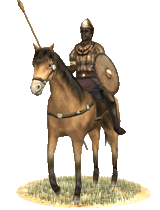 The Ethiopians living in the low coastlands share many cultural traits with the people of Sab’yn, including religious practices. These cavalrymen are drawn from these peoples and are often recruited from the higher ends of Ethiopian society, the families of the nobles and priests. They are equipped with lances and swords in addition to helmets and shields. In battle they can be expected to fight bravely, but as long as they are used properly. The Ethiopians living in the low coastlands share many cultural traits with the people of Sab’yn, including religious practices. These cavalrymen are drawn from these peoples and are often recruited from the higher ends of Ethiopian society, the families of the nobles and priests. They are equipped with lances and swords in addition to helmets and shields. In battle they can be expected to fight bravely, but as long as they are used properly.
Historically, ancient Ethiopia (encompassing modern day Eritrea and northern Ethiopia) was at this time made up of many smaller kingdoms that waged wars against each other, but also against any foreign invaders, like the Nubians, Hellenes and Sabaeans. There were basically three main regions in ancient Ethiopia; the coastal lowlands along the Erythrean Sea, the interior plains and the mountains separating them. The coastal lowlands seem to have been the most prosperous and were often raided by the mountain kingdoms. Most evidence indicates that the Ethiopians living along the Erythrean Sea were the most urbanized and also the most influenced by foreigners who established colonies and trade posts along the coast, like the Hellens and Sabaeans and when it came to the latter, adopted their religious practices, which was a legacy of the earlier Sabaean rule in Ethiopia or D’mt as it was also called, although to which extent Ethiopia was ruled or if it was ruled at all by Sab’yn is a matter of debate. There are also evidences of Judaism being prevalent in ancient Ethiopia due to archaeological findings of temples and altar stones from 500 BC on, resembling ancient Jewish temples and sacrificial altars from 800-600 BC.
Ethiopian warfare at this time seems to have been similar to that of their Nubian neighbours, but there were regional variations in arms and armor when it came to materials used. The dominant type was skirmishers armed with either javelins or bows, and sometimes on horseback. They would also be armed with clubs for close combat. Spearmen were also used and the coastal peoples also fielded small, but elite contingents of swordsmen, either influenced or equipped by foreigners, serving often as bodyguards for kings or chieftains. Ethiopians were accustomed to cavalry warfare, but only as skirmishers, which is why cavalrymen like these would only be raised by Sabaean influence or under Sabaean rule.
Hoplitai Troglodutikes (Red Sea Hoplites)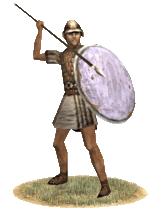 Hoplitai Troglodutikes (Erythraian Sea Hoplites) are mostly Hellenic colonists who were drawn to the Erythraian Sea coast. After initial exploration Ptolemaioi founded colonies in there to hunt elephants and trade with the natives and as far as India. Local garisson forces took part in those hunts and many of the veterans remained on those colonies after retiring. As in each Hellenic polis, a local force of hoplites would be summoned at time of need. Having completed the rigorous "ephebike askesis" they would be ready to fight against their enemies and as such the rigorous demands for citizenship have been lowered to whomever is available. The enemies aren't hoplites or Phallangitai. They are the skirmishers and spearmen of the Troglodytai, the fierce archers of Meroe and Inner Aithiopia, and maybe even the lightly armored but deadly Sabaioi. Hellenic discipline and courage can win the day, but not by underestimation of those enemies. Against those, while retaining the same offensive equipment, (spear and aspis shield), bronze muscle cuirass and linothorax have been dumped in favor of lighter quilted armour. It is easier to wear in the tropics as ancient Aigyptioi had proven. No pteryges, as they add to weight and can raise body temperature. A trusty "machaira" compliments their equipment too. Their helmet is an evolved Boiotian, the ideal helmet for providing some sort of eye protection in the desert and african coast. Their aspis has no bronze coating, relying on elephant skin instead. Natives had been using such an arrangement, for some time. Now Hoplitai Troglodutikes must do the same. Hoplitai Troglodutikes (Erythraian Sea Hoplites) are mostly Hellenic colonists who were drawn to the Erythraian Sea coast. After initial exploration Ptolemaioi founded colonies in there to hunt elephants and trade with the natives and as far as India. Local garisson forces took part in those hunts and many of the veterans remained on those colonies after retiring. As in each Hellenic polis, a local force of hoplites would be summoned at time of need. Having completed the rigorous "ephebike askesis" they would be ready to fight against their enemies and as such the rigorous demands for citizenship have been lowered to whomever is available. The enemies aren't hoplites or Phallangitai. They are the skirmishers and spearmen of the Troglodytai, the fierce archers of Meroe and Inner Aithiopia, and maybe even the lightly armored but deadly Sabaioi. Hellenic discipline and courage can win the day, but not by underestimation of those enemies. Against those, while retaining the same offensive equipment, (spear and aspis shield), bronze muscle cuirass and linothorax have been dumped in favor of lighter quilted armour. It is easier to wear in the tropics as ancient Aigyptioi had proven. No pteryges, as they add to weight and can raise body temperature. A trusty "machaira" compliments their equipment too. Their helmet is an evolved Boiotian, the ideal helmet for providing some sort of eye protection in the desert and african coast. Their aspis has no bronze coating, relying on elephant skin instead. Natives had been using such an arrangement, for some time. Now Hoplitai Troglodutikes must do the same.
Historically Ptolemaioi were very interested in the southern regions of their domain. Akte Troglodutike or the coast of the Troglodutes was perhaps the "wild, unexplored" frontier of the time. The rising elephant hunts as well as the trade with Sabaioi and Indoi, led to the founding of a series of Colonies, with Filotera, "founded by Satyr [a Ptolemaioi general] when he was sent hunting elephants in Troglodytiki" (Strabo,16,4-5) being the first. Soon enough, Arsinoe Troglodytiki, Berenike Troglodytiki, Ptolemais of the Elephantotheron (Elephant hunters) were founded. As frontiermen always do, those people cared more for what someone could do, not the purity of his Hellenic blood. Thus Hellenised Aigyptians and other nationals could be there and perfectly fit in. However rich and promising their situation was, their enemies were at the doors as to a Troglodyte which many of them were, the Colonists were godly rich. The local hoplites fight as ekdromoi mostly, since this is the only way they can effectively deal with the fluid battlefield environment in that area. Colonies in that region existed for many centuries and that was due, in no small part to the ability of their inhabitants to defend them.
|
 |
|
 |






















|